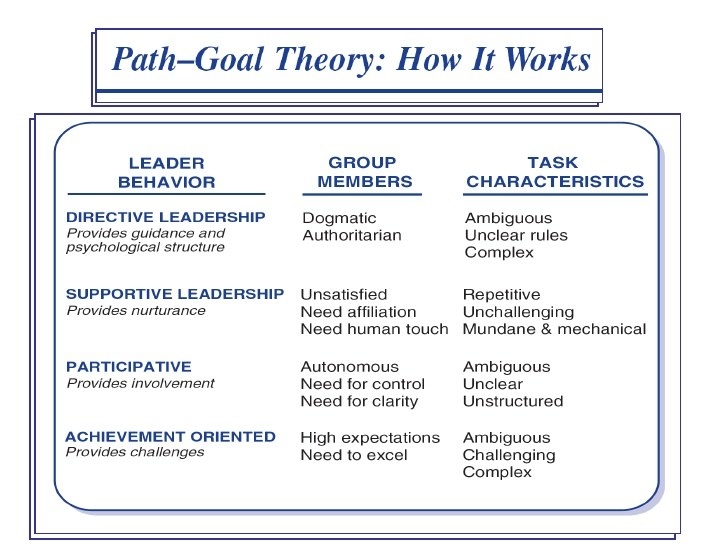The foundation of the Path-Goal Theory is how leaders can help their followers along the path to their goals by selecting specific behaviors that are best suited to their followers' needs and to the situation in which their followers' are working
The Basic Idea Behind the Path-Goal Theory

Major Components of Path-Goal Theory

Leader Behaviors
Follower Characteristics
Task Characteristics

Real-World Experience
For the Path-Goal Theory, the most important thing to know is the four main foundational concepts that this theory is comprised of which is: Defines Goals, Clarifies Path, Removes Obstacles, Provides Support. These four concepts are seen through the different types of leadership that can be demonstrated by a variety of leaders. An example of a real-world experience that highlights the Path-Goal Theory is my recent interaction with my store manage in regards to my performance within Walgreens. Every year we get a performance review and my manager asks us various questions about our work ethic, future goals, and obstacles. This year, I brought it to her attention that every Sunday when I work, we are understaffed compared to the overwhelming number of tasks that need to be completed. After explaining to her the root of the problem, my manager then offered to add one more team member onto our Sunday shift in order to help things run more smoothly and efficiently.
Currently, we have an extra team member on Sunday's and it has truly removed the obstacles my crew and I faced when we were attempting to complete all of our tasks and help customers at the same time. This experience connects to the Path-Goal Theory because through this performance review, my manager has been able gain some insight about the root of the problem. By sitting down together, we were able to define and discuss the specific goals of my Sunday crew and of Walgreens as an organization and then follow up by clarifying the path to get there, such as adding on an extra team members to help us balance out the level of tasks that are expected to be completed. Next, my manager removed the obstacles by rearranging the schedule and making sure that an extra person was added onto the Sunday crew. Lastly, my manager provided support by checking up on me a few weeks later to make sure that the addition of another crew member had tackled the root of the problem and that this change was beneficial in allowing the store to run more efficiently and effectively. For this specific experience, I would say that my manager was a cross between directive and participative leadership because my manager gave me both instructions of what is expected from me as a Shift Lead on a typical Sunday and gave me the opportunity to share in the process of problem-solving by asking for my opinion, thoughts, and suggestions about the situation and possible solutions.

